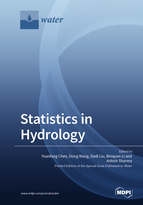Statistics in Hydrology
A special issue of Water (ISSN 2073-4441). This special issue belongs to the section "Hydrology".
Deadline for manuscript submissions: closed (31 December 2021) | Viewed by 32821
Special Issue Editors
Interests: hydrological design; stochastic hydrology; long-term HYDROLOGIC forecasting; risk analysis; water resource assessment and management; water resource protection
Interests: stochastic hydrology; uncertainty and risk analysis; water resource management
Interests: statistical hydrology; hydrological model; water resources management
Interests: hydrological uncertainty; stochastic hydrology; hydrological forecasting; hydrological model; snow hydrology
Special Issue Information
Dear Colleagues,
Statistical methods have a long history in the analysis of hydrological data for designing, planning, infilling, forecasting, and specifying better models to assess scenarios of land use and climate change in catchments. The effectiveness of statistical descriptions of hydrological processes reflects the enormous complexity of hydrological systems, which makes a purely deterministic description ineffective.
This Special Issue is envisioned to showcase the state of the art in statistical hydrology. Potential papers would be selected from the presentations delivered at the 10th International Workshop on Statistical Hydrology, which was organized by the International Commission on Statistical Hydrology, International Association of Hydrological Sciences (ICSH-IAHS), and took place in Nanjing, China on 19–20 October 2019.
A total of 132 participants from 13 countries including China, the United States, Canada, Australia, Italy, Germany, Switzerland, Belgium, Spain, Poland, etc. registered to participate in the conference, and more than 300 graduate students from the organizer (Hohai University) attended the conference. During the conference, a number of international hydrological academics shared their latest research results. These scholars included Prof. Eric Wood from Princeton University (Academician of the American Academy of Engineering), Prof. András Bárdossy from the University of Stuttgart (Foreign Academician of the Hungarian Academy of Sciences), Prof. Salvatore Grimaldi (Vice President of IAHS), Prof. Ashish Sharma (President of ICSH-IAHS), Prof. Qingyun Duan from Hohai University, etc. This conference has inspired many new academic innovations and achievements in the past year. Therefore, it is now a good time to organize a Special Issue to share these achievements.
This potential issue will comprise high-quality papers submitted by the participants of the conference and also welcomes contributions from other scholars that match the topics of this Special Issue.
The issue will mainly cover the following topics:
- Big data, data mining, and assimilation in hydrology;
- Extreme hydrological and meteorological events under climate change;
- Hydrological prediction and its uncertainty;
- Hydrological design and risk assessment under changing environment;
- Eco-hydrological regime changes and uncertainty assessment under human activities.
Prof. Dr. Yuanfang Chen
Prof. Dr. Dong Wang
Prof. Dr. Dedi Liu
Prof. Dr. Binquan Li
Prof. Dr. Ashish Sharma
Guest Editors
Manuscript Submission Information
Manuscripts should be submitted online at www.mdpi.com by registering and logging in to this website. Once you are registered, click here to go to the submission form. Manuscripts can be submitted until the deadline. All submissions that pass pre-check are peer-reviewed. Accepted papers will be published continuously in the journal (as soon as accepted) and will be listed together on the special issue website. Research articles, review articles as well as short communications are invited. For planned papers, a title and short abstract (about 100 words) can be sent to the Editorial Office for announcement on this website.
Submitted manuscripts should not have been published previously, nor be under consideration for publication elsewhere (except conference proceedings papers). All manuscripts are thoroughly refereed through a single-blind peer-review process. A guide for authors and other relevant information for submission of manuscripts is available on the Instructions for Authors page. Water is an international peer-reviewed open access semimonthly journal published by MDPI.
Please visit the Instructions for Authors page before submitting a manuscript. The Article Processing Charge (APC) for publication in this open access journal is 2600 CHF (Swiss Francs). Submitted papers should be well formatted and use good English. Authors may use MDPI's English editing service prior to publication or during author revisions.
Keywords
- statistical hydrology
- stochastic hydrology
- hydrological uncertainty
- big data, data analysis
- extreme hydrological and meteorological events
- hydrological design and risk assessment
- bayesian hydrology
- eco-hydrological uncertainty assessment
- non-stationary hydrological frequency analysis










